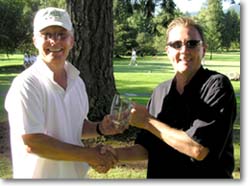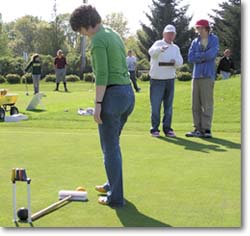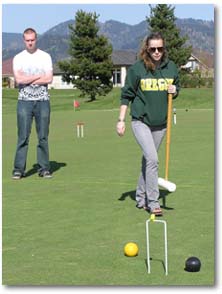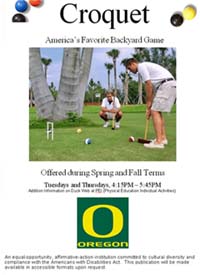
|
Back to |
| The Front Page |
| The Game |
|
Croquet for credit at the University of Oregon |
|
by Bob Alman photos courtesy of Rick Alderson Posted May 30, 2009
|
It was bound to happen somewhere. Following a few short-lived experiments at other American schools, all the right elements came together in Eugene at the University of Oregon: a croquet enthusiast to create a lesson plan; a PE professor to make the case; a nearby golf complex whose owners were willing to make space for croquet; and a longtime US Croquet Association organizer and teacher to conduct the classes in the fall and spring terms.

|
| Rick Alderson (left) is presented the "B" flight first place trophy at the 2008 Oregon Open, held on the two beautiful courts at Resort At The Mountain, on the southern slope of Mount Hood. |
Rick had the right background, as a USCA croquet player since 2003 who became an "A" flight national doubles champion in 2005 and then repeated in singles in 2008. But the foundations for the U of O course were laid much earlier than that, right around the turn of the century when Rick and a few others persuaded the owners of RiverRidge Golf Complex to built a regulation croquet court that was to become the "classroom" of the croquet course.
In the years after RiverRidge owners Ric and Debbie Jefferies installed the court at their complex, several state championships and other tournaments were played on the lawn, but local interest wasn't enough to make the court pay for itself, and Rick and other players started to worry about the future of croquet at RiverRidge.

|
| The class limit of 18 fits the "classroom" size, filling up two courts to the max, doubled-banked for doubles. |
As it happens, the Jefferies had put together a successful college credited golf class, so it occurred to Rick to suggest that they also have a credited croquet course. He talked to Peg Rees, associate director of physical education at the University, who asked him to come up with a program outline - which he did.
|
A COMPLETE "HOW TO" |
|
Rick Alderson maintains that "Any croquet club within 10 to 15 minutes of a university should be able to hold a college croquet class," following the precedent of the University of Oregon, Eugene. Most colleges offer Physical Education "individual activities" as electives for credit, like billiards and juggling. Why not croquet, too? If your club is serious about helping the USCA promote the sport, a college level for-credit class is a valid option. It could also help you raise funds for your club. Rick can give you everything you need: the pitch to make to both the college and the students; the recommended syllabus; and the hands-on wisdom of three years of experience. Email him for all the answers.
|
The plan looked good to the University. So in the fall term, 2007, the University of Oregon in Eugene offered what is believed to be the first college credited croquet class in the country.
The acceptance of Rick's plan made him a paid croquet instructor, and thirteen student enrolled for the first term, but not all of them showed up for the course. "I knew that some dropouts were to be expected, but the smallness of the first class worried me. But at the same time, I knew that new classes sometimes need a term or two to get established by word of mouth."
Nevertheless, in the last few weeks of the first term - in the fall of 2007 - Rick saw signs that the course was working: "The students were coming to class earlier and earlier each day," he said. "They were starting to catch on. They were enjoying the game."

|
| Hanner's game-play instruction begins at the beginning: hoop #1. |
The college course has reinvigorated the RiverRidge Croquet Association, which has additional student traffic after the end of each term, when the students are allowed to continue playing free for a limited period. (After that, they pay for greens time, just like the golfers.) Moreover, the students are allowed to repeat the course once for more PE credit, and repeating makes sense: with the last four sessions devoted to tournaments and the written exam, that leaves only eight 90-minute sessions for learning the physical skills and the complex tactics of the sport.

|
| Even on the lessor court, set with narrow "winter wickets" strict rules of etiquette are observed: No one can be on the court except the player with the innings. |
One of those friends illustrates the coed appeal of croquet, sophomore Alex Hendricks-Clark, majoring in linguistics. He said, "I was very excited, especially when I heard that Allison was also taking the class. Backyard croquet won't do it for me anymore. I'll have to find people to play with and I'm glad I've met these people in this class who know the game."
For the purposes of growing the sport, there's a hard question to be asked at this point: How many of these students will continue with croquet after college, when they're preoccupied with earning a living and maybe even raising a family? "If just one student from each term returns to the sport once they get settled down after college," Rick supposes, "this class will be a success."

|
| Most of the 12 sessions are on the court, but a written exam overlooking the golf course tests the students' mastery of rules, conventions, tactics and strategy. |
Hanner's croquet background gives him the ideal croquet instructor resume. He's produced the Oregon State Association Laws State Championship for the last several years - which the students are invited and encouraged to witness - and is a certified USCA referee. He admits to enjoying his stint as the primary instructor for the spring 2009 term, and "seeing the lights come on as the students discover for themselves what I've been teaching - such as the importance of staying alive on partner. The first time I heard a student say to his partner, 'No, let's not get dead on each other,' it felt like a breakthrough."

|
| Instructor Mike Hanner with the spring class, 2009. |
The biggest breakthrough could be for the sport itself, if the model established by the University of Oregon in Eugene is followed by other colleges and universities.
|
CROQUET IS MORE.....
Rick Alderson adapted material from the USCA's website to create his own pitch to U of O students for the Department of Physical Education and Recreation website for the 2009 spring term.
Now discover the modern sport of six-wicket croquet. Specially built courts and precision equipment set the stage for an addictive game of skill and strategy. The basics are easy to learn, and yet there's always a new level for those who seek a challenge. Croquet is a competitive sport with a relaxed, sociable atmosphere, and a strong tradition of sportsmanship. You will become intrigued by the strategy, much like playing chess. As in the game of billiards, you will learn different shots; the quarter roll, half roll and stop shots. You will learn how to 'run a break,' scoring more than one wicket in a turn. After becoming familiar with the game, free passes will be provided so that you can practice and play as your schedule allows. Your instructors are members of the United States Croquet Association, with many years of instruction and competition to their credit. Give the new modern sport of croquet a try. It is a real kick in the pants. Go Ducks! |
